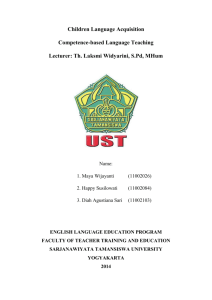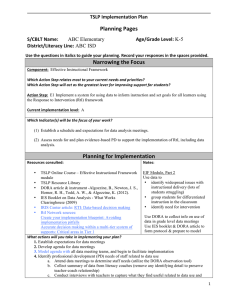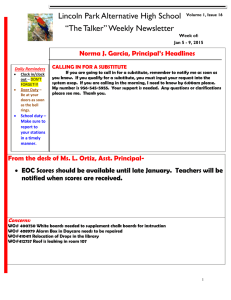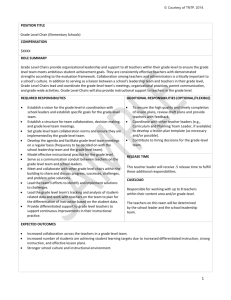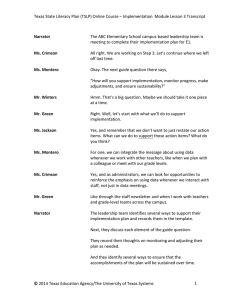Document 13720666
advertisement
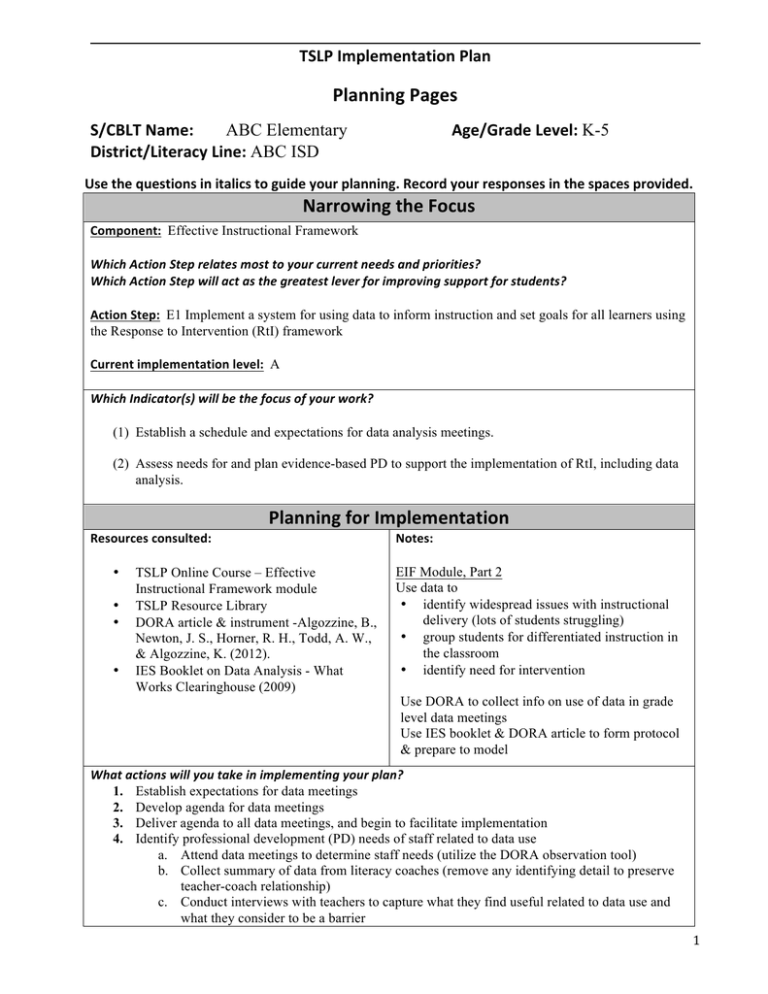
TSLP Implementation Plan Planning Pages S/CBLT Name: ABC Elementary District/Literacy Line: ABC ISD Age/Grade Level: K-5 Use the questions in italics to guide your planning. Record your responses in the spaces provided. Narrowing the Focus Component: Effective Instructional Framework Which Action Step relates most to your current needs and priorities? Which Action Step will act as the greatest lever for improving support for students? Action Step: E1 Implement a system for using data to inform instruction and set goals for all learners using the Response to Intervention (RtI) framework Current implementation level: A Which Indicator(s) will be the focus of your work? (1) Establish a schedule and expectations for data analysis meetings. (2) Assess needs for and plan evidence-based PD to support the implementation of RtI, including data analysis. Planning for Implementation Resources consulted: • TSLP Online Course – Effective Instructional Framework module • TSLP Resource Library • DORA article & instrument -Algozzine, B., Newton, J. S., Horner, R. H., Todd, A. W., & Algozzine, K. (2012). • IES Booklet on Data Analysis - What Works Clearinghouse (2009) Notes: EIF Module, Part 2 Use data to • identify widespread issues with instructional delivery (lots of students struggling) • group students for differentiated instruction in the classroom • identify need for intervention Use DORA to collect info on use of data in grade level data meetings Use IES booklet & DORA article to form protocol & prepare to model What actions will you take in implementing your plan? 1. Establish expectations for data meetings 2. Develop agenda for data meetings 3. Deliver agenda to all data meetings, and begin to facilitate implementation 4. Identify professional development (PD) needs of staff related to data use a. Attend data meetings to determine staff needs (utilize the DORA observation tool) b. Collect summary of data from literacy coaches (remove any identifying detail to preserve teacher-coach relationship) c. Conduct interviews with teachers to capture what they find useful related to data use and what they consider to be a barrier 1 TSLP Implementation Plan 5. Research and identify PD concepts to match identified staff needs 6. Schedule professional development a. Determine delivery method for each PD b. Determine appropriate follow-up steps for all PD Defining Expected Outcomes How will the activities you’ve planned lead to improved support for students? Providing clear expectations for data analysis meetings will include the application of that analysis in planning instruction. When teachers have the guidance and professional development for data analysis and application, they will be expected and empowered to differentiate their instruction to meet student needs. How will you know if your implementation has been successful? What do you expect to see staff/students doing that will indicate success? Short term • Teachers will begin to follow the model (agenda) provided for data analysis meetings • Professional development that is tied to identified needs among the staff is scheduled Long term • Teachers will differentiate their lesson plans according to their findings in data analysis meetings • Students will receive instruction that is differentiated according to their needs in all classrooms Identifying Challenges and Support How will you support implementation, monitor progress, make adjustments, and ensure sustainability? Supporting implementation Campus-based leadership team (CBLT) members will support the plan by emphasizing data analysis and use of data for instruction in their interaction with other staff members, such as through collaborative planning, grade-level meetings, staff meetings, the staff newsletter, and other opportunities as they arise. The literacy coach, Mr. Green, will make a specific point to incorporate data-based decision-making discussions into his individual work with the teachers. The CBLT members assigned to visit grade-level data meetings to collect data for needs assessment will continue to work with those grade-level teams throughout the following year, modeling and monitoring the use of the data analysis agenda and procedures that are developed and presented to staff. The principal, Ms. Jackson, will rotate to different data meetings, making sure to visit each grade-level team every three months. Monitoring progress and making adjustments The CBLT will continue to meet weekly to report their progress and problem-solve as needed. Once the data meeting expectations have been rolled out, “Data Use” will become a standard discussion item at each leadership team meeting. CBLT members will support teams in real time as needed and will brief the CBLT about the most recent data meeting they attended, including feedback from teachers. The team will collaboratively identify successes and difficulties. The CBLT will determine possible solutions for the difficulties and develop plans for necessary adjustments. Ensuring sustainability Sustainability will be facilitated through the development of consistent routines (e.g., the creation of a standard agenda for data meetings, the consistent reinforcement of data-based decision making by the literacy coach, and the ongoing discussion of data use during CBLT meetings). New staff will be trained on the data analysis process and expectations. The CBLT will monitor the effectiveness of the implementation 2 TSLP Implementation Plan of these routines, both in real time (at data meetings) and over time, to evaluate its impact on instructional practices and student outcomes. What do you anticipate as potential challenges? What support is needed? Potential challenges Support to be provided • CBLT knowledge of data use/analysis • Time to study research/resources collected; procedures additional PD for CBLT on data use/analysis procedures • Disconnect between Tier I instruction and • Input from intervention specialists when intervention support (Tier II and Tier III) designing expectations and protocol • Teacher discomfort or misunderstanding of CBLT visits to data meetings • Principal’s direct communication with staff to address concerns Communicating the Plan How will you communicate your plan to school staff? The principal, Ms. Jackson, will give a “big picture” overview to the staff, including the identified Action Step and Indicators and the major steps in the plan. She will explain the data collection that will occur in the needs assessment phase, assuring staff that the data meeting visits are not evaluative and that data will be used only to help inform the next steps in planning and providing support and professional development. Once the data meeting expectations and agenda have been developed, the principal will meet briefly with staff to introduce the expectations and procedures to everyone. CBLT members will model the procedures, guide grade-level teams, and provide ongoing support as needed. Based on the needs assessment, professional development will be scheduled through December 2014. A complete schedule will be delivered to teachers before the end of the school year and revisited at the start of the next school year through staff meetings and grade-level team meetings. 3 TSLP Implementation Plan Plan Summary S/CBLT Name: ABC Elementary District/Literacy Line: ABC ISD Age/Grade Level: K-5 Summarize and record your plan here. General Information Component: Effective Instructional Framework Indicator(s): (1) Establish a schedule and expectations for data analysis meetings. Action Step: E1. Implement a system for using data to inform instruction and set goals for all learners using the Response to Intervention (RtI) framework. (2) Assess needs for and plan evidence-based PD to support the implementation of RtI, including data analysis. Current implementation level: A Rationale for selection: Over the past two years at ABC Elementary School, an increasing number of students have been performing below grade-level literacy expectations. Although a schedule for data meetings is in place, these meetings have not translated into improved student achievement. Members of the campus-based leadership team (CBLT) report witnessing inconsistent application of data analysis into instructional practice. Based on this plan, the CBLT will collect information on current data meeting practices to inform a needs assessment; based on that assessment, professional development will be planned and scheduled. The CBLT will also establish expectations and select or adapt a research-based procedure for data analysis meetings. By assessing needs, establishing effective data-use routines, and supporting data-use practices through professional development and ongoing guidance, ABC Elementary School expects to increase teachers’ effective use of data to (1) differentiate instruction for students’ individual literacy needs and (2) make informed decisions about students needing supplemental (Tiers II/III) instruction. Effectively utilizing data is expected to lead to higher student success. Anticipated completion date: May 2014* Timeline Indicator (1) Establish a schedule and expectations for data analysis meetings. Action item(s) Give an overview of the TSLP Implementation Plan to all staff Build capacity of CBLT on data analysis and use (review of research; PD as needed) Meet with intervention specialists to get input on data analysis meeting expectations Due date 3/17/14 Person(s) responsible Ms. Jackson Documentation 3/28/14 Ms. Crimson CBLT agendas 4/28/14 Mr. Green CBLT meeting agenda, sign-in sheet Staff meeting agenda 4 TSLP Implementation Plan *Note: The action items from February through May will lay the groundwork for these two action items that will need to be done in the next school year. (2) Assess needs for and plan evidence-based PD to support the implementation of RtI, including data analysis. Develop a list of expectations for data meetings 5/5/14 Create a standard data meeting agenda, incorporating expectations 5/5/14 Introduce the data meeting expectations and agenda to instructional staff Revisit data meeting schedule and revise as needed; include CBLT members assigned to grade-level teams Model use of data meeting agenda with grade-level teams 5/19/14 Finalized list Finalized agenda Staff meeting agenda 8/6/14 Each CBLT member Schedule for each team’s data meetings Fall 2014 Each CBLT member Data meeting minutes/notes and sign-in sheets Research and select/adapt a data meeting observation tool 2/17/14 Mr. Green Finalized/selected observation tool Train CBLT members and administrators on data meeting observation tool 3/28/14 Mr. Green Agenda for training(s) Assign CBLT and admin team members to different grade-level teams 3/28/14 Ms. Crimson, CBLT List of assignments Attend assigned data meetings and record observations 4/34/25/14 Ms. Jackson, CBLT, and admin team Data collection sheets, summaries Interview a sample of teachers to capture what they find useful related to data use and what they consider to be barriers 3/174/21/14 Mr. Winters, Ms. Montero Summary of responses to interview questions Summarize data-use practices observed by literacy coach (with no teacher or teams identified) 4/25/14 Mr. Green Summary of current practices Review all data from observations, interviews, and summaries to identify staff strengths and needs 4/28/14 Ms. Montero, CBLT CBLT agenda, list of strengths and needs Research appropriate topics and formats for PD based on identified needs 4/285/5/14 Mr. Green, Ms. Crimson Summary of research Ms. Montero, CBLT CBLT agenda, notes Select PD formats and dates; identify expectations for the staff regarding PD, as well as follow-up support to be provided Ms. Montero, CBLT Ms. Montero, CBLT Ms. Jackson 5/5/14 5 TSLP Implementation Plan Contact PD providers and arrange logistics 5/12/14 Ms. Crimson Final list of PD details Communicate PD expectations and schedule to instructional staff 5/19/14 Ms. Jackson Staff meeting agenda, written expectations, and schedule for PD 6
